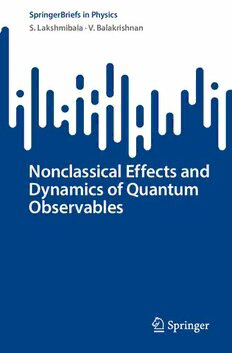
Nonclassical Effects and Dynamics of Quantum Observables PDF
Preview Nonclassical Effects and Dynamics of Quantum Observables
SpringerBriefs in Physics S. Lakshmibala · V. Balakrishnan Nonclassical Effects and Dynamics of Quantum Observables SpringerBriefs in Physics SeriesEditors BalasubramanianAnanthanarayan,CentreforHighEnergyPhysics,Indian InstituteofScience,Bangalore,Karnataka,India EgorBabaev,DepartmentofPhysics,RoyalInstituteofTechnology,Stockholm, Sweden MalcolmBremer,H.H.WillsPhysicsLaboratory,UniversityofBristol,Bristol, UK XavierCalmet,DepartmentofPhysicsandAstronomy,UniversityofSussex, Brighton,UK FrancescaDiLodovico,DepartmentofPhysics,QueenMaryUniversityof London,London,UK PabloD.Esquinazi,InstituteforExperimentalPhysicsII,UniversityofLeipzig, Leipzig,Germany MaartenHoogerland,UniversityofAuckland,Auckland,NewZealand EricLeRu,SchoolofChemicalandPhysicalSciences,VictoriaUniversityof Wellington,Kelburn,Wellington,NewZealand DarioNarducci,UniversityofMilano-Bicocca,Milan,Italy JamesOverduin,TowsonUniversity,Towson,MD,USA VesselinPetkov,Montreal,QC,Canada StefanTheisen,Max-Planck-InstitutfürGravitationsphysik,Golm,Germany CharlesH.T.Wang,DepartmentofPhysics,UniversityofAberdeen,Aberdeen,UK JamesD.Wells,DepartmentofPhysics,UniversityofMichigan,AnnArbor,MI, USA AndrewWhitaker,DepartmentofPhysicsandAstronomy,Queen’sUniversity Belfast,Belfast,UK SpringerBriefsinPhysicsareaseriesofslimhigh-qualitypublicationsencompassing the entire spectrum of physics. Manuscripts for SpringerBriefs in Physics will be evaluatedbySpringerandbymembersoftheEditorialBoard.Proposalsandother communicationshouldbesenttoyourPublishingEditorsatSpringer. Featuring compact volumes of 50 to 125 pages (approximately 20,000–45,000 words),Briefsareshorterthanaconventionalbookbutlongerthanajournalarticle. Thus,Briefsserveastimely,concisetoolsforstudents,researchers,andprofessionals. Typicaltextsforpublicationmightinclude: (cid:129) Asnapshotreviewofthecurrentstateofahotoremergingfield (cid:129) Aconciseintroductiontocoreconceptsthatstudentsmustunderstandinorderto makeindependentcontributions (cid:129) Anextendedresearchreportgivingmoredetailsanddiscussionthanispossible inaconventionaljournalarticle (cid:129) Amanualdescribingunderlyingprinciplesandbestpracticesforanexperimental technique (cid:129) An essay exploring new ideas within physics, related philosophical issues, or broadertopicssuchasscienceandsociety Briefsallowauthorstopresenttheirideasandreaderstoabsorbthemwithminimal time investment. Briefs will be published as part of Springer’s eBook collection, withmillionsofusersworldwide.Inaddition,theywillbeavailable,justlikeother books, for individual print and electronic purchase. Briefs are characterized by fast,globalelectronicdissemination,straightforwardpublishingagreements,easy- to-usemanuscriptpreparationandformattingguidelines,andexpeditedproduction schedules.Weaimforpublication8–12weeksafteracceptance. · S. Lakshmibala V. Balakrishnan Nonclassical Effects and Dynamics of Quantum Observables S.Lakshmibala V.Balakrishnan DepartmentofPhysics DepartmentofPhysics IndianInstituteofTechnologyMadras IndianInstituteofTechnologyMadras Chennai,India Chennai,India ISSN 2191-5423 ISSN 2191-5431 (electronic) SpringerBriefsinPhysics ISBN 978-3-031-19413-9 ISBN 978-3-031-19414-6 (eBook) https://doi.org/10.1007/978-3-031-19414-6 ©TheAuthor(s),underexclusivelicensetoSpringerNatureSwitzerlandAG2022 Thisworkissubjecttocopyright.AllrightsaresolelyandexclusivelylicensedbythePublisher,whether thewholeorpartofthematerialisconcerned,specificallytherightsoftranslation,reprinting,reuse ofillustrations,recitation,broadcasting,reproductiononmicrofilmsorinanyotherphysicalway,and transmissionorinformationstorageandretrieval,electronicadaptation,computersoftware,orbysimilar ordissimilarmethodologynowknownorhereafterdeveloped. Theuseofgeneraldescriptivenames,registerednames,trademarks,servicemarks,etc.inthispublication doesnotimply,evenintheabsenceofaspecificstatement,thatsuchnamesareexemptfromtherelevant protectivelawsandregulationsandthereforefreeforgeneraluse. Thepublisher,theauthors,andtheeditorsaresafetoassumethattheadviceandinformationinthisbook arebelievedtobetrueandaccurateatthedateofpublication.Neitherthepublishernortheauthorsor theeditorsgiveawarranty,expressedorimplied,withrespecttothematerialcontainedhereinorforany errorsoromissionsthatmayhavebeenmade.Thepublisherremainsneutralwithregardtojurisdictional claimsinpublishedmapsandinstitutionalaffiliations. ThisSpringerimprintispublishedbytheregisteredcompanySpringerNatureSwitzerlandAG Theregisteredcompanyaddressis:Gewerbestrasse11,6330Cham,Switzerland Preface Ourjobinphysicsistoseethingssimply,tounderstanda greatmanycomplicatedphenomenainaunifiedway,in termsofafewsimpleprinciples. —StevenWeinberg Thedividebetweenclassicalandquantumphysics,whereandhowthisdivideblurs, andproposalstoidentifygenuinelyquantumeffectshavebeenaspectsofimmense interestforresearcherssincetheearlydaysofthediscoveryofquantumlaws.Several questionsofbothphilosophicalandpracticalimportancehavebeenraisedthrough differentapproachestounderstandingtheseaspects.Notably,opticsprovidesanideal platformforexaminingpossibleoverlapsbetweentheclassicalandquantumworlds, asinterference,coherence,polarization,andevenentanglementcanberecognized, experimentallytested,andanalyzedwithinboththeclassicalandquantumsettings. Significantprogressinidentifyinginherentlyquantumeffectshasbeenmadeinrecent yearsbymeansofnovelexperimentssupportedbytheoreticalarguments.Inmany situations,however,universallyacceptablequantitiesthatwillunequivocallysignal theclassicalorquantumnatureofspecificphenomenaarenotavailable. Notsurprisingly,therefore,diverseapproacheshavebeendevelopedevenwithin thesettingofoptics,inordertoexaminetheunderlyingnatureofphysicalprocesses asvariedasphotosynthesis,superradiance,andmanifestationsofentanglement.The availability of several novel states of light that are nonclassical in the sense that they depart from ideal coherence, and could exhibit different types of squeezing, has given tremendous impetus to both theoretical and experimental investigations aimedatunderstandingtheoverlapbetweentheclassicalandquantumdescriptions. Theframeworkofspinsystemsandhybridquantumsystemsoflight-matterinterac- tionsprovidesthepossibilityofexaminingnonclassicaleffectsinrelativelylower- dimensional Hilbert spaces than those of continuous variables, as exemplified by theradiationfield.Extensivecurrentresearchusestheseplatformstounderstandthe natureofgenuinequantumentanglementanditsconnections,ifany,withsqueezing. Inthiswork,wefocusprimarilyontwoapproachestounderstandingthequantum regime.Thefirstisbasedontherecognitionthatthebasiclawsofprobabilitytheory v vi Preface governboththeclassicalandquantumdomains.Muchworkisbeingdonetounder- stand the quantum nature of macroscopic phenomena using tests based on proba- bilitytheory.Inparticular,werecognizethat,whilequasiprobabilityfunctionssuch astheWignerdistributionareusedasstandardidentifiersofthenonclassicalityof quantumstates,thetomogramsfromwhichtheyareconstructedaregenuineproba- bilitydistributions.Investigationscarriedoutusingonlytomograms(weshallrefer tothislooselyasthetomographicapproach)couldhelpinunderstandingthelimi- tations on extracting information about quantum states without undertaking state reconstruction from tomograms. The second approach is based on the recognition that the temporal evolution of quantum observables could well be converted into longtimeseriesofdata,andthetoolsoftimeseriesandnetworkanalysis,whichare well developed in the treatment of classical dynamical variables, could be applied tosuchdata.Togetherwiththeunderstandingthatthequantumwavepacketrevival phenomenonissimilartoPoincarérecurrencesinclassicalphasespace,thisapproach has the potential to identify the limitations of the classical toolbox in a quantum setting. Since our focus is primarily on these two approaches, it is inevitable that thereferencescitedinthisworkcompriseonlyasmallsubsetoftheextensiveand growingliteratureonnonclassicaleffects,tomograms,andtheanalysisoflargedata sets. We acknowledge with pleasure discussions with several former students of ours over more than two decades, which enhanced our comprehension of several aspectsofquantumphysics.Inparticular,werecallnumeroushelpfulconversations withDrs.S.Seshadri,C.Sudheesh,AthreyaShankar,PradipLaha,andB.Sharmila. Our sincere thanks to Pradip for readily creating and sharing a substantial part of thecontentsandplotsthatwehaveusedinChaps.3,6,and7.Thisworkwouldnot havebeenpossiblebutforthepainstakingandtirelesseffortputinbySharmilawho hasbeenwithusthrougheverystageofthepreparationofthismanuscript,sharing relevantfilesandformattingthevariouschapters.Ourveryspecialthankstoher.We alsothankDr.S.Ramananforherinvaluabletechnicalassistanceduringtheprepa- rationofthemanuscript.Finally,werecordourthankstoDrs.B.Ananthanarayan (IISc)andLisaScalone(Springer)foreditorialadviceandsupport. The authors weresupported, inpart,byagrant fromMphasis tothe Center for QuantumInformation,Communication,andComputing(CQuICC). We dedicate this work with affectionate gratitude to our respective parents and grandparents. Chennai,India S.Lakshmibala September2022 V.Balakrishnan Contents 1 Introduction ................................................... 1 References ..................................................... 17 2 Revivals,FractionalRevivalsandTomograms ..................... 21 2.1 Introduction ............................................... 21 2.2 BasicMechanismofWavePacketRevivals ..................... 23 2.3 AnIllustrativeExample ..................................... 24 2.4 SignaturesofRevivalsinExpectationValuesofObservables ...... 26 2.5 EffectofanImperfectlyCoherentInitialState .................. 29 2.6 RevivalsinSingle-ModeSystems:ATomographicApproach ..... 32 2.7 DecoherenceEffects ........................................ 36 2.8 ATomographicApproachtotheDouble-WellBECSystem ....... 37 References ..................................................... 41 3 TomographicApproachtoSqueezing ............................ 43 3.1 Introduction ............................................... 43 3.2 EntropicSqueezingfromOpticalTomograms .................. 45 3.3 Quadrature and Higher-Order Squeezing from Optical Tomograms ................................................ 48 References ..................................................... 52 4 EntanglementatAvoidedLevelCrossings ........................ 53 4.1 Introduction ............................................... 53 4.2 EntanglementIndicatorsfromOpticalandQubitTomograms ..... 55 4.3 EntanglementIndicatorsandSqueezinginSpinSystems ......... 58 4.4 BipartiteCVModelsandAvoidedLevelCrossings .............. 63 4.5 Avoided Crossings in Multipartite HQ Systems: The Tavis–CummingsModel ..................................... 66 References ..................................................... 68 vii viii Contents 5 Dynamics and Entanglement Indicators in Bipartite CV Systems ....................................................... 71 5.1 Introduction ............................................... 71 5.2 TheBipartiteAtom-FieldInteractionModelRevisited ........... 72 5.2.1 TimeEvolution ...................................... 72 5.2.2 EntanglementDynamics .............................. 75 5.2.3 TomographicEntanglementIndicatorsDuringTime Evolution ........................................... 77 5.3 TheDouble-WellBECModelRevisited ....................... 79 5.3.1 TimeDevelopment ................................... 79 5.3.2 DecoherenceEffectsintheDouble-WellBECModel ...... 80 References ..................................................... 81 6 DynamicsofEntanglementIndicatorsinHybridQuantum andSpinSystems ............................................... 83 6.1 Introduction ............................................... 83 6.2 TheDoubleJaynes-CummingsModel ......................... 84 6.2.1 Dynamics ........................................... 84 6.2.2 EquivalentCircuitfortheDJCModelandtheIBMQ Platform ............................................ 86 6.3 TheDoubleTavis-CummingsModel .......................... 88 6.3.1 TheModel .......................................... 88 6.3.2 EquivalentCircuitandtheIBMQPlatform .............. 88 6.4 BipartiteEntanglementinTripartiteModels .................... 89 6.4.1 TheCavityOptomechanicalSystem .................... 90 6.4.2 (cid:2)-AtomInteractingwithRadiationFields ............... 93 6.5 EntanglementandSqueezinginNMRExperiments .............. 96 6.5.1 NMRExperimentI ................................... 98 6.5.2 BlockadeandFreezinginNuclearSpins ................. 101 6.6 ConcludingRemarks ........................................ 104 References ..................................................... 105 7 Dynamics of the Mean Photon Number: Time Series andNetworkAnalysis .......................................... 107 7.1 Introduction ............................................... 107 7.2 BriefOverviewofTimeSeriesAnalysis ....................... 108 7.3 TheBipartiteAtom-FieldInteractionModel:TimeSeries Analysis .................................................. 110 7.3.1 Dynamics ........................................... 110 7.3.2 PowerSpectrumandLyapunovExponent ................ 111 7.3.3 RecurrenceStatistics ................................. 113 7.4 Three-LevelAtomInteractingwithRadiationFields ............. 114 7.5 TheTripartiteHQModelwithIntensity-DependentCouplings .... 116 7.5.1 TheModel .......................................... 116 7.5.2 TimeSeriesAnalysiswithLargeandSmallDataSets ..... 117 7.5.3 ReturnMapsandRecurrenceTimeDistributions ......... 118 Contents ix 7.5.4 RecurrencePlotsandRecurrenceNetwork ............... 119 7.5.5 NetworkAnalysis .................................... 123 7.6 ConcludingRemarks ........................................ 125 References ..................................................... 125 8 ConclusionandOutlook ........................................ 127
